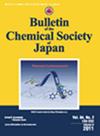Step-growth irreversible deactivation radical polymerization: synergistic developments with chain-growth reversible deactivation radical polymerization
IF 3.8
3区 化学
Q2 CHEMISTRY, MULTIDISCIPLINARY
引用次数: 0
Abstract
Recent advances in chain-growth reversible deactivation radical polymerization (CG-RDRP), i.e. the so-called “living radical polymerization”, have synergistically developed step-growth radical polymerizations via controlled formation of radical species from covalent bonds followed by irreversible deactivation of the resulting radical species. The monomers for radical polyaddition are thus designed to possess carbon–halogen or thioester bonds, which can generate radical species in the presence of transition metal catalysts and radical initiators, as well as carbon‒carbon double bonds, which will irreversibly form carbon–halogen or thioester bonds. Radical polycondensations are achievable via radical coupling reactions of carbon-centered radicals generated from carbon–halogen bonds or radical quenching reactions with nitroxides. Furthermore, radical addition-condensation polymerizations are achieved by a sequence of reactions, i.e. the formation of radical species from carbon–halogen bonds, radical addition to nitroso or thiocarbonylthio compounds, and coupling or quenching reactions with the resulting stable radical. These step-growth irreversible deactivation radical polymerizations (SG-IDRP) enable the synthesis of a variety of polymers, such as polyethers, polyesters, polyamides, and polyimides, which have aliphatic, aromatic, polar, and degradable groups in their main chains. Sequence-regulated vinyl polymer structures can also be constructed by designing monomers. Combinations with CG-RDRPs further lead to unique hybrid block, multiblock, graft, hyperbranched, and network polymers.阶跃生长不可逆失活自由基聚合:与链式生长可逆失活自由基聚合的协同发展
链增长可逆失活自由基聚合(CG-RDRP),即所谓的 "活自由基聚合 "的最新进展,通过控制共价键形成自由基种类,然后对所产生的自由基种类进行不可逆失活,从而协同发展了阶跃生长自由基聚合。因此,用于自由基加成的单体被设计为具有碳-卤素键或硫酯键,在过渡金属催化剂和自由基引发剂的存在下可产生自由基物种,以及碳-碳双键,这将不可逆地形成碳-卤素键或硫酯键。通过碳-卤键产生的碳中心自由基的自由基偶联反应或与硝化物的自由基淬灭反应,可实现自由基缩聚。此外,自由基加成缩合聚合是通过一系列反应实现的,即由碳-卤素键形成自由基种类,与亚硝基或硫代羰基硫化合物发生自由基加成反应,以及与所产生的稳定自由基发生偶联或淬灭反应。这些阶跃生长不可逆失活自由基聚合反应(SG-IDRP)能够合成各种聚合物,如聚醚、聚酯、聚酰胺和聚酰亚胺,这些聚合物的主链中含有脂肪族、芳香族、极性和可降解基团。还可以通过设计单体来构建序列调控乙烯基聚合物结构。与 CG-RDRP 相结合,可进一步生成独特的混合嵌段、多嵌段、接枝、超支化和网络聚合物。
本文章由计算机程序翻译,如有差异,请以英文原文为准。
求助全文
约1分钟内获得全文
求助全文
来源期刊
CiteScore
6.40
自引率
5.00%
发文量
194
审稿时长
3-8 weeks
期刊介绍:
The Bulletin of the Chemical Society of Japan (BCSJ) is devoted to the publication of scientific research papers in the fields of Theoretical and Physical Chemistry, Analytical and Inorganic Chemistry, Organic and Biological Chemistry, and Applied and Materials Chemistry. BCSJ appears as a monthly journal online and in advance with three kinds of papers (Accounts, Articles, and Short Articles) describing original research. The purpose of BCSJ is to select and publish the most important papers with the broadest significance to the chemistry community in general. The Chemical Society of Japan hopes all visitors will notice the usefulness of our journal and the abundance of topics, and welcomes more submissions from scientists all over the world.

 求助内容:
求助内容: 应助结果提醒方式:
应助结果提醒方式:


